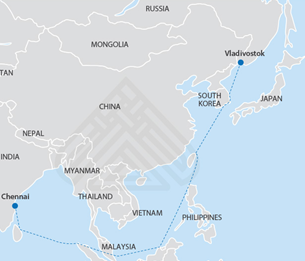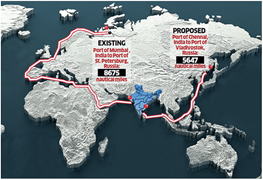

Context
India and Russia have scheduled a stakeholder meeting in September to work out the details for operationalising the Chennai-Vladivostok maritime route.
History
- The Chennai-Vladivostok maritime link is not a new phenomenon — it did operate for a few years during the Soviet period.
- It was very much operational between 1967 and 1969; and the shipment took nearly 90 days given the shipping technology at work then following the maritime route Nakhodka, Hong Kong, Singapore, Calcutta, and Madras.
- Recent development: The Chennai-Vladivostok maritime connectivity was first crystallised at the policy level during the visit of Prime Minister Narendra Modi to Vladivostok in 2019 to attend both the Eastern Economic Forum (EEF) and the annual Indo-Russia bilateral summit.
- It was during this visit that the two sides signed a Memorandum of Intent (MoI) on the Development of Maritime Communications between the Port of Chennai and the Port of Vladivostok.

- It was during this visit that the two sides signed a Memorandum of Intent (MoI) on the Development of Maritime Communications between the Port of Chennai and the Port of Vladivostok.
About the route
- The Chennai-Vladivostok Maritime route connects Chennai on India’s east coast with Vladivostok, Russia’s eastern port city, opening a plethora of opportunities for trade and investment for both countries.
- Vladivostok is the end point of the Trans-Siberian Railway, the fourth in terms of cargo turnover, and the first free seaport of the Far East.
- The Vladivostok-Chennai route passes through the Sea of Japan past the Korean peninsula, Taiwan and the Philippines in the South China Sea, past Singapore and through the Strait of Malacca, to emerge into the Bay of Bengal and then cuts across through the Andaman and Nicobar archipelago to Chennai.
- This sea route covers a distance of approximately 5,647 nautical miles or about 10,500 km.
|
Present route
|
The need of new route
- Lack of connectivity is one of the reasons for limited trade between India and Russia, which has for the past few years hovered around the US $12-13 billion level.
- Reduced transportation time: The proposed route will bring down transport time to 12 days, almost a third of what is taken under the existing popular route from Petersburg to Mumbai.
|
Far East
|
- Reduced cost: Costs are expected to experience a substantial decrease, by 30-odd per cent.
- Presence in South East Asian region: The new route would also give India the largest presence in the South East Asian region.
- Ideal gateway: The strategic location of Chennai Port on the Bay of Bengal makes it an ideal gateway for trade with Southeast Asian countries like Thailand, Vietnam, and Indonesia.
- Immense opportunities: Similarly, the Port of Vladivostok in Russia provides access to the resource-rich Far East region, offering immense opportunities for Indian businesses to tap into the market sectors like energy, mining, and technology.


